June Drake and Silverton Schools
(From 100 Years of Education in Marion County - 1957)
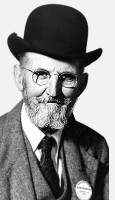 Editors Note: This piece is from a compilation of histories of Marion County, Oregon Schools was the culminating project of the Marion County NEA Centennial Committee, who also organized and sponsored a Birthday Banquet April 5, 1957. Governor Robert Holmes, the featured speaker, addressed an audience of two hundred educators and distinguished guests with a speech in keeping with the Centennial theme, "An educated people Moves Freedom Forward." What follows, is the entry for Silverton Schools, written by Silvertron photographer June Drake.
Editors Note: This piece is from a compilation of histories of Marion County, Oregon Schools was the culminating project of the Marion County NEA Centennial Committee, who also organized and sponsored a Birthday Banquet April 5, 1957. Governor Robert Holmes, the featured speaker, addressed an audience of two hundred educators and distinguished guests with a speech in keeping with the Centennial theme, "An educated people Moves Freedom Forward." What follows, is the entry for Silverton Schools, written by Silvertron photographer June Drake.
The writer of this school history has been a resident of this community for 77 years and has lived in Silverton continuously since the fall of 1889. I attended the local schools, as did my father, my children, and grandchildren.
I am thankful to my parents, Edna Brown, Mary Stormer, Hannah Olsen, old schoolmates, and teachers of the past, as well as the present, for their able assistance.
I am especially thankful to our County School Superintendent, Agnes C. Booth, for their willing help.
The first pioneers who came to the great Oregon country were a hardy-God-fearing people who were not afraid to work. Among them were doctors, preachers, educators, and skilled tradesmen. They had to be, or they would not have survived the aw1ful hardships that confronted them on every hand.
Besides eking out a living, there were two things they wanted most, the right to worship as they saw fit and to give their children a liberal education. One of the earliest homeseekers was Daniel Waldo and family, who took up a Donation Land Claim of 640 acres in what is now the Waldo Hills, arriving there Dec. 1, 1843. Mr. Waldo's first thought was to build a home and then to provide an education for his children.
In 1845, he and some helpers built a log house with a dirt floor near his home, to be used as a schoolroom. He secured a teacher who taught all the children for miles around. Mr. Waldo's son, John B. Waldo, later became Justice of the Supreme Court of Oregon.
The first school, actually built within the limits of what is now Silverton, was a log building constructed in 1849 by the people living close by. This building was at what is now Grant and North Water Streets.
The school was taught by Elizabeth Coffey and there were 31 pupils in attendance. They were from the families of James Brown, Leander Davis, Doctor Blackerby, Harpole, Cox, Smith, Pitman, and others.
The next year, 1850, a more centrally located one-room schoolhouse was built at what is now Oak and Water Streets. This school was built of hewn poles and rough lumber of various widths. It was not edged. The building was covered with shakes. The seats and desks were made of rough lumber; the teacher was Montgomery Barger. The next teacher was a Mr. Grover, who taught one term. Thomas Coon, a new arrival, taught two more terms.
On September 14, 1855, a group of Silverton citizens succeeded in having Silverton School District No. 4 of Marion County formed. John Barger was appointed as the first clerk. Clark P. Crandall succeeded Barger as second clerk and on April 26, 1856, drew $37. 05 from the County school funds.

In 1855, a 20 x 30 ft, two-room schoolhouse was built near where the Silverton Green House on South Water Street is now located. Each room had a fireplace made of rock, clay, and wood. This building was painted white. All desks and furnishings were hand made. The men who taught in this schoolhouse were Paul Crandall, William Cline, and George Dolan.
In the year 1858, there were 59 pupils in the Silverton district.
The year 1862 found a new two-story, two-room school building in use. Each room was provided with an entrance and cloak room, the desks and seats were home-made, and all lumber used was hand planed. The building was painted white inside and out and had no belfry at first. One was added in the seventies when a bell was secured. This building was built on part of Thomas Coon's Donation Land Claim and located between North Water and First, next to Park Street, Dr. P. A. Davis was clerk of the district in 1862 and 1863, and there were 96 school age children in the district.
The district money in 1863 was $88.77. In 1864, Solomon Hirsch drew the school money amounting to $180. In this year, there were 66 boys and 54 girls attending school. The two teachers received only $300 for their services of five months. By the year 1866, the number of school age children in district No. 4 of Silverton had increased to 161, and the amount of school funds was $223.50. This two-room school building that was built in 1862 still remains in use. It stands at High and 3rd Streets and is owned by the Modern Woodmen.
In 1872, George W. Dolan was clerk. The school population had fallen to 129, as other districts had been formed, cutting away part of District No. 4.
According to the first issue of the Silverton Appeal, published in 1880, Mr. Guild, editor, said, "Silverton has 41 pupils in a two-room school, D. W. Yoder as principal."
This was not all the school age children within the district. Mr. Yoder was a large, obese man and always carried a cane with a crook for a handle, and often used this crook to drag an unruly boy from his seat for punishment.
In 1889, the pupils overflowed this two-room schoolhouse and Helen Hibbard was engaged to teach the older pupils uptown in the upstairs room of the Good Templar Hall. The teachers in the schoolhouse were J. W. Roberts and Grace Blackerby.

In the spring of 1890, the school directors let a contract for the construction of a new six-room school building (above) to be completed in time for the fall term of school, said building to be built in the center of the lot where the old two-room building stood. The old building was sold to the GAR (Grand Army of the Republic), and was moved by J. K. Buff to the corner of Park and First Streets, where the building remained until the land was needed for a High School Building in 1907.
The fall of 1890 found four rooms of the new six-room school in use. The principal was A. L. Briggs; other teachers were Hattie Starette, Grace Blackerby, and Helen White. It was not until about 1900 that all six rooms were in use.
E. T. Moores, a native of Silverton and a graduate of the Willamette University of Salem became principal of the Silverton Schools in 1.897 and established classes to the tenth grade. In June of 1898, the first class of students graduated from the tenth grade or what is now called High School. There were eight in the class, as follows: Hilda Olsen, Kate Freeman, Elma Fish, Edgar Fish, Tillie Foss, Sam Foss, Roy Skaife and Emory Drake.
1903 was a sad year for all of the teachers and pupils in the Silverton Schools. During the winter when Silver Creek was on a rampage, Principal William Parker's son, Charlie, who was about twelve years old, fell into the swollen waters of Silver Creek near dark while crossing the railroad bridge and was drowned. The boy's body was not recovered until the next afternoon, when it was found by Roy Fitzjerald about one mile down stream.
Teachers besides Mr. Parker who taught in 1903, were Eleanor Shoenfeld, now Mrs. J. D. Drake; Miss Ethel Lemmon, Now Mrs. P. L. Brown; Miss Clara Sullivan; Miss Carry Ridings, who married Clyde Marquam; and Miss Missamore. Other noted teachers in this school were Mr. Craps and E. T. Moores who became Marion County's Superintendent of Schools.
Later on this school building was named the Emerson. In 1918, this large six-room school building was moved to the corner of First and A. Streets to make room for a new grade school of brick construction. The Emerson School Building burned to the ground during a freeze-up the winter of 1925. The cause of the fire was defective motor wiring and lack of water, as hydrants were frozen up.
In 1907 a six-room high school named Washington Irving was erected (below). The building had a basement of stone and walls of brick cemented outside. It was built at First and Park Streets and was used continuously for school purposes until 1934. This building was traded to the City of Silverton for the athletic field at the end of Brown Street. E. E. Washburn was superintendent and Mattie Kentner was principal of the school's new high school. Miss Kentner followed by Ward Wray in 1909, who held the position for several years. He was followed by William Goetz who held the position for some time.
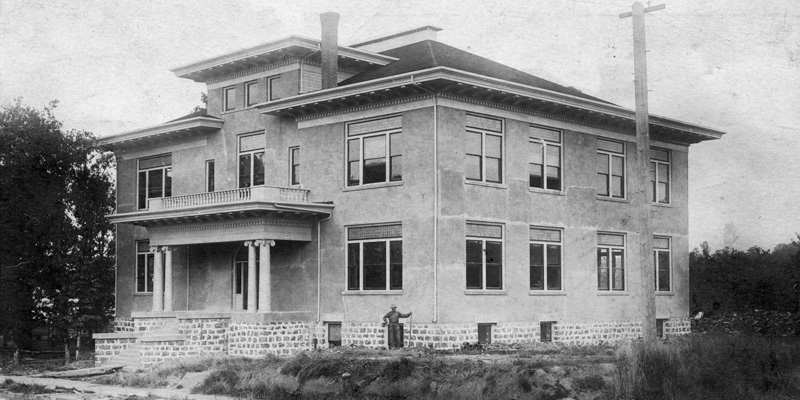
The first basketball team to be organized in Silverton was in 1900, at the Liberal University at Grant Street and Bethany Road. It is not known when basketball entered the Silverton schools, but it soon followed the University team.
The Silverton Schools did not have a gymnasium and they had to rent a room in the Silverton Opera House which was built in 1907. Silverton's high school basketball team (below) won the state championship tournament played at Corvallis in 1909. The coach was Ed Rule of Yale, manager was Wallace (Dock) Cooley and the players were Don Ross, Eddie Fischer, William (Klink) Steelhammer, Charles Reynolds, Erwin Brooks, and Chet Woolcott.
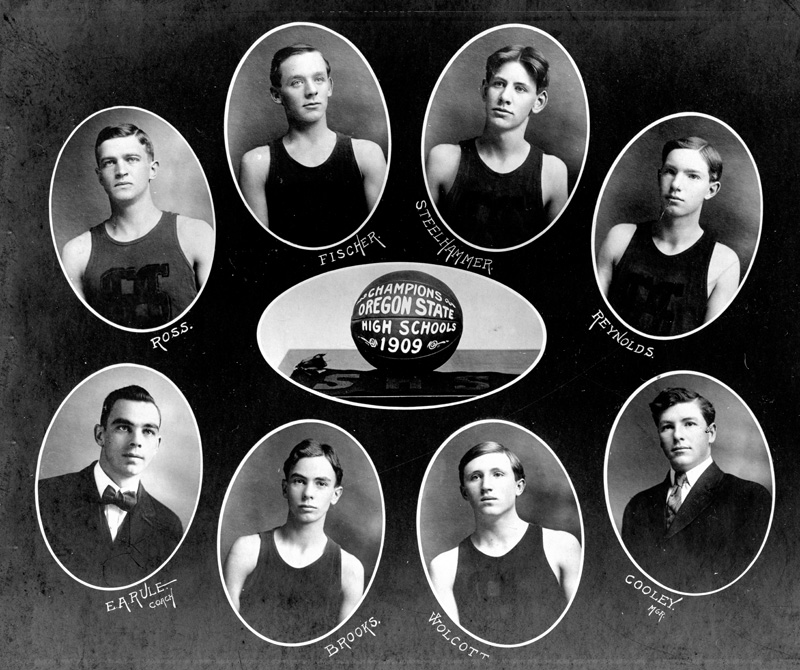
The Liberal University of Oregon was named by its promoters - John E. Hosmer, Minnie Page Hosmer and Pearl W. Geer, who first opened a secular school in 1906 in the Liberal Hall which was over the J. Wolfard General Merchandise Store, corner of Main and Water Streets in Silverton. This was an experimental school which was the only one of its kind in the world. After a struggle of three years the number of student increased considerably.
Thaddeus B. Wakeman, a graduate of Princeton and a practicing attorney of New York City moved with his family to Silverton and joined the school's faculty.
In 1899 a Colorado friend of the school deeded his farm to the University as an endowment fund nucleus.
The school board purchased a 40-acre tract of land just outside of the City limits on Pine and Grant Streets, where a two-story wooden building with full basement was erected in 1899 in time for the fall term of school. A boarding and rooming house was also constructed in connection with the school. Students attended from far and near, staying at this rooming house and at private homes uptown.

The faculty of this school (above), included: President John E. Hosmer, Mathematics and Physical Science; A. B. Leonard, M. D., Anatomy and Biology; T. B. Wakeman, Supt., Gen. History, Linguist and Law; Minnie P. Hosmer, Preparatory Dept., History, Grammar; Pearl W. Geer, Secretary, Business and Correspondence; G. W. Hoffman, Physics, Botony, Mathematics; Mary Childers, primary classes; Sophie Wolf, piano, elocution, and English Literature; M. G. Cooley, violin and coronet; Clara Wakeman, Art; Alice Davenport, Stenography and Typing; Emily Wakeman, Domestic Science; Louis E. Ranch, Asst. Bookkeeping and Commercial Arithmetic; Lora Ames, Physiology, Hygiene; and Katie Mattesan, Librarian.
The University also owned and published a weekly paper, The Torch of Reason. This school was incorporated for $50,000.
Some internal dissension sprang up among the officers, and the school moved to Kansas City, Missouri, in 1903, where it finally folded up. The building in Silverton was idle for some time, and was finally sold to a Catholic organization.
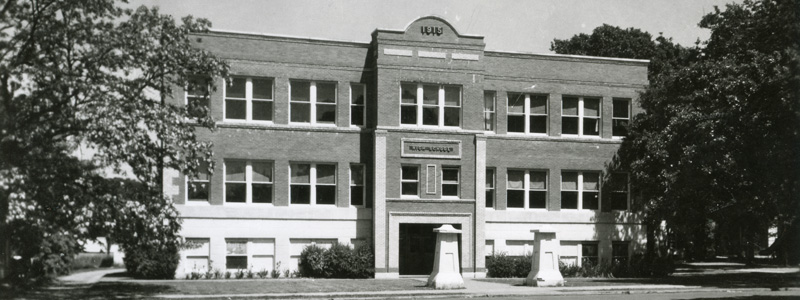
Silverton's Junior High (above) was built in 1915 on First Street between Park and A, Streets. It was constructed of brick and had a stage and facilities for home economics. This building was taken over by the high school because their building was crowded. The Junior High occupied the old High, the Washington Irving Building. The principal of the High School at that time was Byron Conkle. After the high school moved into its new building on Schlador Street, this school was used for seventh and eighth grades and was condemned in 1955. It was replaced by a new, modern building called Mark Twain School which is between North Church and North Mill Streets at Robinson Street, The new building has nine classrooms, gymnasium, library, and spacious halls. This school was first occupied in January of 1957, with Tom Cutshall in charge. The sixth grade was moved from Eugene Field school to join the seventh and eighth grades in the new school building.
In 1918 the six-room wooden grade school building that was named the Emerson was moved to the corner of First and "A" Streets to make room for a new brick building to be known as the Eugene Field School, (below). The first unit built in 1918 at the corner of North Water and Park Streets, contained office space, seven classrooms and an auditorium-gymnasium combination. M. B. Ford is the present principal, having held the position for twelve years.

The burning of the Emerson school caused a shortage of classrooms and a second unit of the Eugene Field School of 10 rooms was built, facing Park Street. In 1925, a third unit of six classrooms and basement was built on the north facing North Water Street.
The Eugene Field Building at first was heated by steam coming from a wood-heating plant across the street between the High and Junior High Schools. An oil heating plant was installed in 1954 to furnish heat for the Eugene Field Building.
In 1945, the PTA arranged and had served complete hot lunches in a room set aside for this purpose. By 1948, the directors of the district saw the benefit of the hot lunches for the children and took over the program that was started by the PTA.
In 1920, the St. Paul's Church congregation purchased the old Liberal University Building on Grant Street, where they held church and started the St. Paul's School in 1921, with 28 pupils in attendance. This building was razed in 1948, and a new brick school and seminary was built. This school had 97 pupils enrolled January 1, 1950, and 103 in January, 1955.
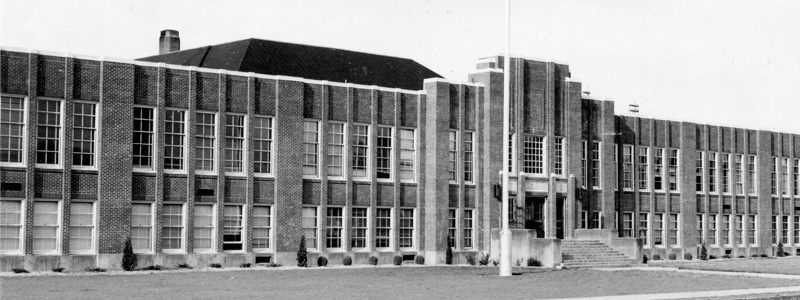
A new, modern, brick senior high school (above) was built at the end of Brown Street next to the athletic field in 1937. Herman Kramer, was first principal of this school. He was followed by Harold Davis, A. B. Anderson, Howard George, Milt Baum and Karl Kahle, Jr., who is the present principal.
In 1954, eleven outlying school districts voted to unite with District No. 4 of Silverton. They formed a Union High School District to include the small communities near Silverton. This district was called 7J and included Silverton District No. 4C that had previously taken in Silver Falls District No. 85; Bethany No. 63C which includes Hazel Dell District No, 41; Butte Creek No. 67J, composed of Marquam No. 16 and Thomas No. 67; Central Ho well 40C that combined with Brush Creek No. 19 in 1955; Crooked Finger No. 97; Evans Valley 33C which includes McLaughlin 75, Abiqua 105, and Brier Knob 114; Evergreen No. 10; Mt. Angel 91, (which absorbed Milster District No. 94 during the early nineteen hundreds, and now rent classrooms from the Mt. Angel parochial school); Monitor 14CJ includes the school districts of Mountain View No. 93, Hullt No. 107, Bridge Creek 133, and Porter 127, which previously took over David No. 95 and Ross District; Scotts Mills No. 73 CJ includes Noble 116; Victor Point No. 42C includes besides itself Valley View 110, McAlpin 54,. Union Hill No. 42, Oak Grove 16, Silver Cliff 35 and Center View 86. Willard District No. 30, a small community lying five miles west of Silverton voted and came into the fold of Silverton 7J in 1956.
In 1956, a multipurpose room, a business education section, kitchen, faculty and a conference room and administration unit were built as an addition to the Union High School Building which brings the unit up to date. To keep the Silverton Schools running smoothly, they are under the supervision of Superintendent Milton Baum, who serves both 7J, the Union High School District and 4C, the Elementary School.
Karl Kahle is principal of the Union High School which has an enrollment of 497 students requiring 25 teachers, Thomas Cutshall is principal of the New Mark Twin School which has 260 students in sixth, seventh and eighth grades and nine teachers, a librarian, and part-time band instructor.
M. B. Ford has charge of the lower elementary grade school in the Eugene Field Building, where there are 500 pupils from kindergarten through fifth grades, 16 teachers and a part-time librarian.

